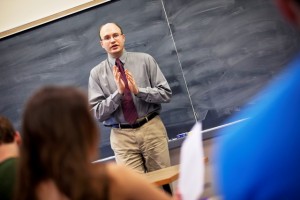
Professor Jeff Liebner
As a second-grader, Jeff Liebner wanted to teach first grade. When he was in third grade, he was ready to teach second. So it’s no surprise that the assistant professor of mathematics found his passion in teaching as an adult.
“I had this idea that I had just been exposed to something great, and I wanted everyone else to know about it,” he says.
Today, that something great usually involves statistics. The inherent logic of math has always appealed to him, as well as definitive right and wrong answers, so it’s a little ironic that he finds himself in the “sometimes gray field” of statistics. In a world saturated with data, he uses statistics to make sense of it all.
“Statistics opens up the door to exposing the truth about the world,” Liebner says. “The beauty of statistics is its versatility and ability to be applied almost anywhere. I always try to stress to my students, especially those taking my introductory courses, that there is a reason their majors or disciplines require a course in statistics besides simply filling a math requirement. It is too easy to be overwhelmed by sheer numbers and to misunderstand what is really going on in life. In our everyday lives, we see these numbers in newspapers, online, on television, or in other forms of media.”
As a graduate student at Carnegie Mellon University, where he earned master’s and doctorate degrees, Liebner began branching into other fields. As part of a team that modeled the behavior of a neuron as it’s exposed to different stimuli, Liebner observed that while it seems the neuron interacts with its environment randomly, there is actually a probability model dictating how often it fires. And that’s directly applicable to the real world—understanding this model, he says, can help researchers develop better prosthetic limbs for amputees.
But Liebner doesn’t limit his statistical observations to just neuroscience. Like he tells his students, statistics is useful wherever there is data—that is, everywhere, in every field. That’s why one of his favorite class projects involves students finding a newspaper or website article that abuses or misuses statistics. By understanding statistics better, they’re better equipped to discuss real-world problems.
Students are often surprised to learn how an author or headline writer misunderstood results or emphasized inconclusive results. That moment of understanding is Liebner’s favorite part of teaching. He often gets emails from students telling him how they use statistics in their careers.
“As a professor, nothing is more inspiring than looking out at a field of students and seeing light bulbs going off as everything suddenly makes sense,” he says. “Statistics is a tool they can use in their future that will help them attempt to discover that elusive truth. It should not be a class that they have to suffer through to get their degree; it should be an arrow in their quiver of tools that is always there for them to use.”
Liebner’s own research illustrates just how interdisciplinary statistics can be. He’s modeling inflation persistence with Julie Smith, assistant professor economics, and Ed Gamber, professor and head of economics; studying the economic loss and gain associated with gift giving with Chris Ruebeck, associate professor of economics; and looking at option pricing with Qin Lu, associate professor of mathematics, Don Chambers, Walter E. Hanson/KPMG Peat Marwick Professor of Business and Finance, and mathematics-economics major Matt Foy ’12 (Morristown, N.J.).
Along with his entire Mathematical Statistics class, he’s analyzing the senior and alcohol surveys for the Counseling Center. He’s also continuing his work on curve fitting that began in summer 2010 with three students, including mathematics major Jiaqi Li ’12 (Jing Zhou, China).
